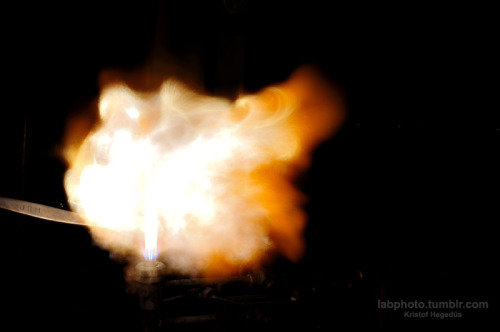Fibonaccite - I'm Always A Slut For Knowledge

More Posts from Fibonaccite and Others
i love to do intense research on things that have zero impact on my life and have no correlation whatsoever to my general interests. i know a lot about combustion engines


Cyanuric triazide or 2,4,6-triazido-1,3,5-triazine is white crystalline solid when pure and is an organic primary explosive with a detonation velocity of about 7,300 m·s-1. More than enough to remove a few fingers, so don’t even think about making it.
It is a quite interesting compound, since it only contains carbon and nitrogen, 3 carbon and 12 nitrogen in each molecule and 9 of these are in 3 azido groups. The compound is highly shock sensitive, it explodes while grind in a mortar. It has a sharp melting point a bit under 100 °C but it explodes upon heating above 200 °C giving nitrogen and elemental carbon as graphite and maybe some diamonds.
Since this compound is a highly sensitive energetic material I would recommend to do not try it out how this works. On the picture and the gif approx. 40-50 mg (0,04-0,05 g) cyanuric triazide was ignited. Even this small amount could be enough to cause serious damage, injury.
Anyone want to read short reviews from energetic materials?
I remember first learning that you can cry from any emotion, that emotions are chemical levels in your brain and your body is constantly trying to maintain equilibrium. so if one emotion sky rockets, that chemical becomes flagged and signals the tear duct to open as an exit to release that emotion packaged neatly within a tear. Everything made sense after learning that. That sudden stability of your emotions after crying. How crying is often accompanied by the inability to feel any other emotion in that precise moment. And it is especially beautiful knowing that it is even possible to experience so much beauty or love or happiness that your body literally can’t hold on to all of it. So what I’ve learned is that crying signifies that you are feeling as much as humanely possible and that is living to the fullest extent. So keep feeling and cry often and as much as needed

You probably don’t look this adorable when you swim… The deep-sea flapjack octopus, Opisthoteuthis “adorabilis,” is a cirrate octopus—meaning that a pair of hairlike filaments surround each sucker on its eight webbed arms. Incirrate octopuses—like the giant Pacific octopus—do not have these cirri, and are more commonly found in shallower waters.
A flapjack octopus can use its arms as a parachute to pulse about and catch the current, while two earlike fins help it maneuver over the deep sea floor. Find out more about our research on this adorable and mysterious critter!
-
 kaleb-is-definitely-sane reblogged this · 1 month ago
kaleb-is-definitely-sane reblogged this · 1 month ago -
 casualtrashwerewolf liked this · 4 months ago
casualtrashwerewolf liked this · 4 months ago -
 writinwater420 liked this · 11 months ago
writinwater420 liked this · 11 months ago -
 zoya-of-the-garden liked this · 11 months ago
zoya-of-the-garden liked this · 11 months ago -
 lost-heartofpassion liked this · 1 year ago
lost-heartofpassion liked this · 1 year ago -
 blvckvot-blog reblogged this · 1 year ago
blvckvot-blog reblogged this · 1 year ago -
 pardon-my-obsessive-tendencies reblogged this · 1 year ago
pardon-my-obsessive-tendencies reblogged this · 1 year ago -
 kvnsk liked this · 1 year ago
kvnsk liked this · 1 year ago -
 tgfangirl4eva liked this · 1 year ago
tgfangirl4eva liked this · 1 year ago -
 contnigame liked this · 1 year ago
contnigame liked this · 1 year ago -
 calythe liked this · 1 year ago
calythe liked this · 1 year ago -
 aquietwhyme liked this · 1 year ago
aquietwhyme liked this · 1 year ago -
 thehawkowl liked this · 2 years ago
thehawkowl liked this · 2 years ago -
 iwillhaveamoonbase liked this · 2 years ago
iwillhaveamoonbase liked this · 2 years ago -
 mychemicalinsanity liked this · 2 years ago
mychemicalinsanity liked this · 2 years ago -
 oh-god-i-wish-i-had-an-octopus reblogged this · 2 years ago
oh-god-i-wish-i-had-an-octopus reblogged this · 2 years ago -
 oh-god-i-wish-i-had-an-octopus liked this · 2 years ago
oh-god-i-wish-i-had-an-octopus liked this · 2 years ago -
 noonthemoon liked this · 2 years ago
noonthemoon liked this · 2 years ago -
 darkadria7 liked this · 2 years ago
darkadria7 liked this · 2 years ago -
 baronessofmischief liked this · 2 years ago
baronessofmischief liked this · 2 years ago -
 captain-cargoshorts liked this · 3 years ago
captain-cargoshorts liked this · 3 years ago -
 tickleheart1 reblogged this · 3 years ago
tickleheart1 reblogged this · 3 years ago -
 squeackygee reblogged this · 3 years ago
squeackygee reblogged this · 3 years ago -
 1212-is-my-lucky-number liked this · 3 years ago
1212-is-my-lucky-number liked this · 3 years ago -
 bonnistic liked this · 3 years ago
bonnistic liked this · 3 years ago -
 squeackygee reblogged this · 3 years ago
squeackygee reblogged this · 3 years ago -
 v3rmine liked this · 3 years ago
v3rmine liked this · 3 years ago














